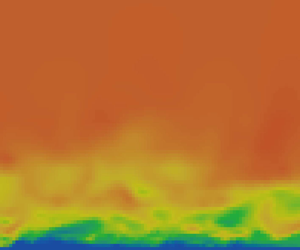Article contents
The impact of non-frozen turbulence on the modelling of the noise from serrated trailing edges
Published online by Cambridge University Press: 12 August 2024
Abstract

Serrations are commonly employed to mitigate the turbulent boundary layer trailing-edge noise. However, significant discrepancies persist between model predictions and experimental observations. In this paper, we show that this results from the frozen turbulence assumption. A fully developed turbulent boundary layer over a flat plate is first simulated using the large-eddy simulation method, with the turbulence at the inlet generated using the digital filter method. The space–time correlations and spectral characteristics of wall pressure fluctuations are examined. The simulation results demonstrate that the coherence function decays in the streamwise direction, deviating from the constant value of unity assumed in the frozen turbulence assumption. By considering an exponential decay function, we relax the frozen turbulence assumption and develop a prediction model that accounts for the intrinsic non-frozen nature of turbulent boundary layers. To facilitate a direct comparison with frozen models, a correction coefficient is introduced to account for the influence of non-frozen turbulence. The comparison between the new and original models demonstrates that the new model predicts lower noise reductions, aligning more closely with the experimental observations. The physical mechanism underlying the overprediction of the noise model assuming frozen turbulence is discussed. The overprediction is due to the decoherence of the phase variation along the serrated trailing edge. Consequently, the ratio of the serration amplitude to the streamwise frequency-dependent correlation length is identified as a crucial parameter in determining the correct prediction of far-field noise.
Information
- Type
- JFM Papers
- Information
- Copyright
- © The Author(s), 2024. Published by Cambridge University Press
References
- 7
- Cited by


